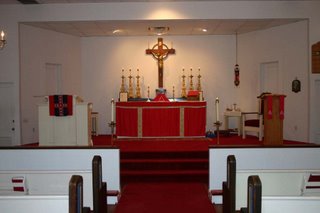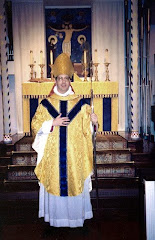 The photo at left is of the sanctuary of St. Hilda of Whitby Anglican Catholic Church in Atlanta, Georgia on June 14th, 2004. The church is vested for the celebration of the feast of a martyr bishop, Blessed Leonidas Polk. June 14th is also the feast of Ss.Anastasius, Felix, and Dignii. They constitute a part of those saints known as the New Martyrs of Cordoba.
The photo at left is of the sanctuary of St. Hilda of Whitby Anglican Catholic Church in Atlanta, Georgia on June 14th, 2004. The church is vested for the celebration of the feast of a martyr bishop, Blessed Leonidas Polk. June 14th is also the feast of Ss.Anastasius, Felix, and Dignii. They constitute a part of those saints known as the New Martyrs of Cordoba.Martyed by the Moors at Cordoba about 852. Anastasius was an old priest of Cordoba, Felix was a monk originally out of North Africa, Dignii was a fiery young nun who was ordered killed after she upbraided the Judge in open court for the injustice of the sentences against Father Anastasius and Brother Felix
Another New Martyr of Cordoba is St. Columbii another nun who confronted the authorities directly about the Islamic prohibition on preaching Jesus.
I have in my possession first class relics of Anastasius, Dignii and Columbii.

























2 comments:
What about all the Muslim and Jewish martyrs who died being burned, hanged and/or publicly
disemboweled at the decree of Her Most Catholic Majesty Queen Isabella of Spain in the 15th Century? Are they not martyrs, too?
Bill Kinsland
I love the internet.
(môrĭs'kōz) [Span.,=Moorish], Moors converted to Christianity after the Christian reconquest (11th–15th cent.) of Spain. The Moors who had become subjects of Christian kings as the reconquest progressed to the 15th cent. were called Mudéjares. They remained Muslim, and their religion and customs were generally respected. After the fall of Granada (1492), Cardinal Jiménez converted many Moors by peaceful means. However, the rigorous treatment of those who refused conversion or apostatized from the new faith led to an uprising (1500–1502) in Granada. This was soon suppressed. Faced with choosing between conversion or banishment, the majority accepted conversion, but many continued secretly to practice Islam. The Moriscos at times provided the Ottoman Turks with information facilitating Turkish raids on the Spanish coast. Persecuted by the Spanish Inquisition and subjected to restrictive legislation (1526, 1527), the Moriscos rose in a bloody rebellion (1568–71), which Philip II put down with the help of John of Austria. The Moriscos prospered in spite of persecutions and furthered Spanish agriculture, trade, and industries. However, in 1609 Philip III, influenced by Lerma, decreed their expulsion for both religious and political reasons.
Bibliography
See H. C. Lea, The Moriscos of Spain (1901, repr. 1969).
History 1450-1789: Moriscos
Home > Library > History, Politics & Society > History 1450-1789
First recorded in 1500, the term Moriscos denotes Muslims who converted to Christianity after the fall of Granada in 1492. In effect, Morisco constitutes a highly ambiguous religious-ethnic designator. From Muslims living near the Ebro River in Aragon to long-standing Castilian Mudéjares (Muslim subjects of the Christian monarchs) and from Valencian Muslims tied to local seigneurs to the conquered communities of Granada, this great variety of Muslim peoples converted to Christianity at various times and under different circumstances.
The conquest of Granada set in motion a process that would herald the conversion of Granadan and Castilian Muslims by 1502. Initially, the surrender capitulations granted extensive freedom of religion to Muslims. Their conversion to Christianity through preaching and patient persuasion—a proselytizing process always favored by the monarchy—began under Archbishop Hernando de Talavera. However, when Cardinal Francisco Jiménez de Cisneros arrived in the city in 1497, he forced the mass conversion of Granada's elches—descendants of Christians converted to Islam. This violation of the capitulations resulted in a violent revolt in 1499. Although the rebellion extended to the countryside, by 1501 the royal government's troops emerged victorious. In exchange for amnesty, Muslims throughout the kingdom converted to Christianity en masse. By 1504, approximately 150,000 Moriscos populated the Kingdom of Granada.
Castille's Mudéjares, numbering approximately 20,000, having lived in relative peace and tranquillity, now faced the repercussions of the Granadan insurrection. Instituting an explicitly militant policy, the royal government ordered their conversion in lieu of expulsion in 1502. Almost all converted to Christianity.
Muslims in the Kingdom of Aragon constituted, after those in Granada, the most important community in the Iberian peninsula. Valencia's Mudéjares may have numbered almost 100,000. Those in Aragon have been estimated at 50,000, while Catalonian Muslims numbered no more than 10,000. Protected by the local Christian nobility—especially in Valencia where Muslims constituted the cornerstone of the seignorial economy—these communities were initially able to avoid the fate that befell their Castilian brethren. By 1522, however, widespread popular revolts in Valencia—the germanías—led to forced conversions of many Muslims. By 1525 the royal government ordered all remaining Aragonese Muslims to convert.
Thereafter, this large population of nominal Christians, still adhering to some degree to Islamic religious practices and Arab cultural norms, presented a host of problems. The royal government and the church hovered uneasily between patient evangelization and repressive assimilation. Until 1570, official attitudes towards Moriscos stressed tolerance and catechism. Morisco communities were sometimes spared investigation by the Spanish Inquisition, and some cultural manifestations such as traditional dress and dances were more or less tolerated. Even when inquisitors tried Moriscos for practicing Islam, the penalties applied were rather lenient. As it became evident, however, that Moriscos continued to resist attempts toward assimilation, attitudes increasingly hardened and Morisco religious and cultural practices were conflated and interpreted as signs of subversion.
In 1568 the widespread Morisco revolt of the Alpujarras in Granada against the increasing control placed upon their cultural and economic activities resulted in a bloody war that lasted until 1570. Drastic measures were taken in the revolt's aftermath. In four years, approximately 80,000 Granadan Moriscos were relocated to the Castilian interior and interspersed among Old Christians—Christians who apparently did not descend from converted Muslims or Jews. Moreover, the state adopted repressive policies against any kind of religious or cultural sign that denoted Islamic heritage. The Inquisition stepped up its prosecution of Moriscos. Assimilationist policies were curtailed, and Moriscos faced increasing hurdles in various cultural and professional pursuits.
Meanwhile, Morisco resistance to acculturation increased. Whereas some evidence points to increasing Christian influence in religious literature in the first half of the sixteenth century, by the 1580s Morisco communities and families had learned to defend their Islamic religious and cultural practices. Often with women safeguarding ancestral knowledge, Moriscos successfully resisted pressures the state heaped upon them to assimilate.
In some ways, however, Moriscos and Old Christians continued to cooperate and enjoy cordial relations. Local studies have shown that Moriscos and their Old Christian neighbors often lived in relative harmony, continuing commercial transactions and economic cooperation. Some evidence even suggests that the efforts by church and state to highlight religious and cultural differences between Moriscos and Old Christians exacerbated social tensions that were mild beforehand.
By the early seventeenth century, the failure of Morisco assimilation, the fear of their contacts with the Ottomans, Barbary pirates, and Protestants, and the increasingly virulent polemics against them convinced the royal government to issue an edict of expulsion. Between 1609 and 1614 almost 300,000 Moriscos left Spain, mostly for North Africa and Constantinople, although, later, many secretly returned and effectively assimilated into the dominant culture. After 1614, traces of Moriscos both in Spain and in their new homes slowly disappear from archival records. Some Moriscos established a semi-independent pirate state in Salé, Morocco, and even entered unsuccessful negotiations with the royal government to return to Spain in 1631. Other Moriscos arrived in Tunis and established a strong cultural and commercial presence. (Chronicles referred to them until the middle of the eighteenth century.) Slowly, Moriscos became integrated into the dominant cultures of their new homelands, even as they left an imprint of their Spanish identity in various commercial and cultural pursuits that retained Spanish language and practices for decades.
The short-lived history of the Moriscos has had an appreciable impact on Spanish historiography. Their contribution to Spanish society, their level of assimilation or resistance, the attitudes of the state and the Old Christian majority, and the effects of their expulsion have consistently recurred as viable themes because they strike at the heart of Spanish political sensibilities and provide material for various historiographical traditions seeking to forge a particular view of a national past. Moreover, the vagaries of the place of Morisco communities within Christian society are particularly relevant for our understanding of various early modern phenomena—the rise of the state, the increasing marginalization of minorities, and the delicate balance between central processes and everyday local structures—and these are reflected in the growing production of scholarship on Moriscos.
Bibliography
Berco, Cristian. "Revealing the Other: Moriscos, Crime, and Local Politics in Toledo's Hinterland in the Late Sixteenth Century." Medieval Encounters 8, no. 2–3 (2002): 135–159.
Cardaillac, Louis, ed. Les Morisques et l'Inquisition. Paris, 1990.
Chejne, Anwar G. Islam and the West: The Moriscos, a Cultural and Social History. Albany, N.Y., 1983.
Domínguez Ortiz, Antonio, and Bernard Vincent. Historia de los moriscos. Vida y tragedia de una minoría. Madrid, 1978.
Halavais, Mary. "Like Wheat to the Miller: Community, Convivencia, and the Construction of Morisco Identity in Sixteenth-Century Aragon." Ph. D. diss., University of California San Diego, 1997. Published electronically at www.gutenberg-e.org.
Lea, Henry Charles. The Moriscos of Spain: Their Conversion and Expulsion. Philadelphia, 1901.
López-Morillas, Consuelo. "Language and Identity in Late Spanish Islam." Hispanic Review 63, no. 2 (1995): 183–210.
Phillips, Carla Rahn. "The Moriscos of La Mancha, 1570–1614." Journal of Modern History 50, no. 2 (1978): D1067–D1095.
Surtz, Ronald E. "Morisco Women, Written Texts, and the Valencian Inquisition." Sixteenth Century Journal 32, no. 2 (2001): 421–433.
—CRISTIAN BERCO
Post a Comment